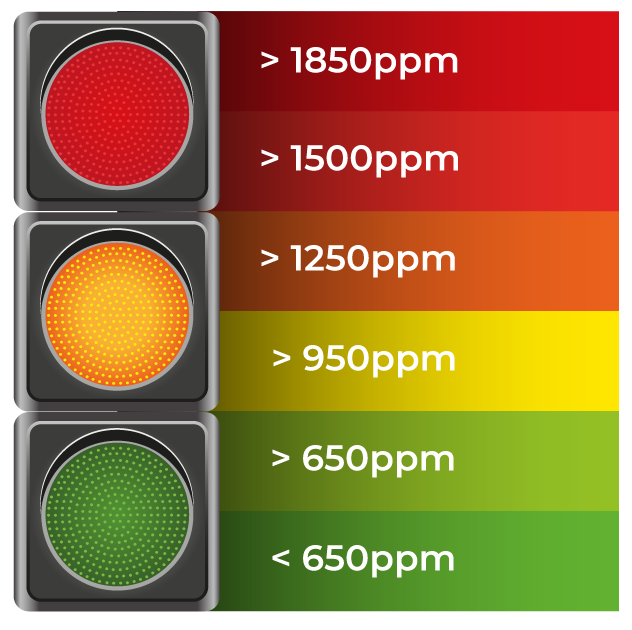
The higher the proportion of CO₂ particles, the higher the proportion of air already breathed.
Due to current occupational health and safety regulations, it is recommended that the quality of the air be checked via a CO₂ measurement and ensured by increased ventilation. The CO₂ value gives an insight into how often the air has already been exhaled and is therefore a very good indicator of aerosols in the air, which include the coronavirus and other flu viruses.
The buildings that are equipped with a modern ventilation system have a clear advantage. But very many buildings get fresh air only through open windows. In winter, however, the windows cannot remain open all the time. Wherever a quick conversion to a new air conditioning or ventilation system is not possible, CO₂ sensors can provide a remedy.
Do you want to ensure good breathing air in your company?
Unsere IoT-Experten geben Ihnen gerne Hilfestellung bei der Umsetzung.
Indoor climate in offices
In offices, the main issue is to ensure optimal working conditions. This includes the CO₂ value, not only as a proxy for aerosols in the air, carbon dioxide itself is also relevant. At higher values, the ability to concentrate drops significantly and thus strongly influences work performance. But other factors are also relevant; temperatures that are too warm or too cool are usually obviously unpleasant. Humidity also plays, in addition to the feeling of well-being, a clear role in the cold season. If the relative humidity is too low (below 40%), the mucous membranes dry out and thus deactivate an important protective mechanism against infections. Higher values of humidity, in turn, lead to particles being able to stay in the air significantly longer.
The low cost of setting up an IoT network pays off twice over when other functions are also integrated. The daily work routine is affected by external factors. For example, the calculation of office space is made more difficult because the presence of employees in home office hours becomes an unpredictable factor. Presence sensors register the presence of a person at the table or meeting room tablets show on the meeting room whether it is booked or not. This even goes so far as to synchronize with their Outlook or Google Calendar, providing professional, workable solutions.

Fit room climate sensors for offices

Room Climate in Schools
Air quality in schools has been discussed for years in connection with asbestos, PCBs, particulate matter or in the context of energy-related building renovation. But it's not just about health: factors such as oxygen content, lighting conditions and temperature also affect performance in classrooms. The Commission on Indoor Air Hygiene (IRK) of the Federal Environment Agency therefore issued guidelines for schools back in 2008 with its "Guidelines for Indoor Air Hygiene in School Buildings." Since the spread of Covid-19, the discussion about effective protective measures has brought air quality into the public eye.
A low CO2 content is an indication that the virus load in the aerosols is also low. To prevent children and teachers from freezing and to keep heating costs in check, no one wants to ventilate more frequently and for longer than necessary during the cold season. But how do teachers know the guidelines for when, how often, and how long they should open the windows? A good basis for decision-making is data from measurements that provide information on whether the air quality complies with the official guideline values.
Room climate sensors for schools
Indoor climate in workshops
"Where work is done, chips fall" This sentence counts more than ever. It depends on which materials are used and what the individual local conditions are like. Overall, numerous indoor air pollutants occur in workrooms and workshops that are harmful to humans. Working with wood can produce large amounts of fine dust, so protective equipment is mandatory. Fine dust sensors can additionally help to train the attention for the occurrence and if necessary give alarm at limit values.
Another focus is on organic volatile compounds (VOCs). When materials are processed, some of these become gaseous and are thus released into the indoor air. They are frequently found in varnishes, paints and adhesives and are therefore encountered on an everyday basis. The vapors usually cause headaches and irritate the mucous membranes. There are also brilliantly harmless VOCs such as terpenes that are found in wood, but some also cause more severe discomfort. Furthermore, other chemical or organic materials are used in crafts as well as in construction and for very many of them there are special LoRaWAN sensors.

Room climate sensors for workshops
Indoor climate in sport studios
The demands on the indoor climate in sports studios are enormous. In the training area, a lot of oxygen is consumed and stale air is exhaled. In these rooms, the humidity rises quickly and strongly due to evaporation from the exercisers. Wearing masks during exercise is hardly possible and aerosols are even increasingly exhaled, which makes the conditions for operation in the colder season even more complex. At the same time, the more they need pleasant conditions during sports. The air must be constantly exchanged and the temperature and humidity must remain constantly comfortable.
In the shower area, on the other hand, there are different conditions. It needs warmer temperatures and the humidity is even higher than in the training rooms. Depending on the equipment, there is also a swimming area and/or a wellness area with massage rooms and sauna. These are additional factors that make the indoor climate in gyms complex. LoRaWAN can be used to set up an individual IoT network that measures the relevant data at specific points and sounds the alarm if necessary.
Room climate sensors for sport studios
You need an IoT room climate solution?
There is no one general IoT solution for indoor climate either. Every case is special and we consult with our customers every day to find the right solution for their unique situation. Whether it's sourcing specific sensors, advising on which hardware is best, training your staff to run an IoT network or implementing one, we are your trusted contact for IoT.




